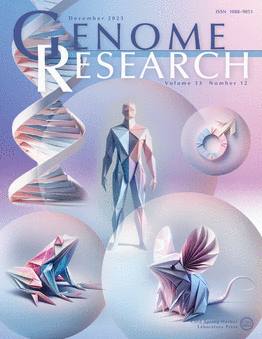Intergenic accumulation of RNAPII maintains the potential for swift transcriptional restart upon release from quiescence
IF 5.5
2区 生物学
Q1 BIOCHEMISTRY & MOLECULAR BIOLOGY
引用次数: 0
Abstract
Quiescent cells (Q) are seemingly inactive, developmentally arrested cells, whose universal characteristic is the ability to promptly reenter the cell cycle upon sensing of external cues. Q cells are responsive to the environment and flexible enough to adapt to available resources. In budding yeast, quiescent nuclear features are drastically distinct from those observed in nutrient replete conditions: the nuclear volume is reduced, the telomeres relocate from the nuclear periphery to the center of the nucleus into a hypercluster, chromatin is found in a compacted, hypoacetylated state, and transcription is globally shutdown. Yet, Q cells can restart transcription within minutes of refeeding. Here, we follow the global decrease of transcription in sorted, developing Q populations, and its reactivation upon release. We find that transcription and telomere clustering dynamics in and out of quiescence are independent events. We report a genome-wide redistribution of the transcription machinery as cells progress into quiescence. Although most genes are shut down, 3% of coding genes remain active. Furthermore, RNAPII accumulates at one third of gene promoters. The corresponding genes are highly enriched among those showing a high level of transcription and high frequency of expression in individual cells, shortly after cells are refed, as monitored by single-cell RNA-seq. Our results point toward a role for quiescent-specific RNAPII distribution to ensure a rapid and robust transcriptional response upon return to growth.基因间RNAPII的积累维持了从静止状态释放后快速转录重启的潜力
静止细胞(Q)是一种看似不活跃、发育停滞的细胞,其普遍特征是能够在感知外部信号后迅速重新进入细胞周期。Q细胞对环境有反应,并且足够灵活以适应可用的资源。在出芽酵母中,静止核的特征与在营养充足的条件下观察到的核的特征截然不同:核体积减少,端粒从核外围重新定位到核中心形成一个超簇,染色质被发现处于紧致的低乙酰化状态,转录被全局关闭。然而,Q细胞可以在重新进食的几分钟内重新开始转录。在本研究中,我们追踪了经过分类、发育中的Q种群中转录的整体减少,以及释放后转录的重新激活。我们发现转录和端粒聚类动力学在静止和脱离静止是独立的事件。我们报告了随着细胞进入静止状态,转录机制在全基因组范围内的重新分配。尽管大多数基因被关闭,但仍有3%的编码基因保持活跃。此外,RNAPII在三分之一的基因启动子上积累。通过单细胞RNA-seq监测,在细胞被冷冻后不久,在单个细胞中表现出高水平转录和高频率表达的基因中,相应的基因高度富集。我们的研究结果指出了静止特异性RNAPII分布的作用,以确保在恢复生长时快速而强大的转录反应。
本文章由计算机程序翻译,如有差异,请以英文原文为准。
求助全文
约1分钟内获得全文
求助全文
来源期刊

Genome research
生物-生化与分子生物学
CiteScore
12.40
自引率
1.40%
发文量
140
审稿时长
6 months
期刊介绍:
Launched in 1995, Genome Research is an international, continuously published, peer-reviewed journal that focuses on research that provides novel insights into the genome biology of all organisms, including advances in genomic medicine.
Among the topics considered by the journal are genome structure and function, comparative genomics, molecular evolution, genome-scale quantitative and population genetics, proteomics, epigenomics, and systems biology. The journal also features exciting gene discoveries and reports of cutting-edge computational biology and high-throughput methodologies.
New data in these areas are published as research papers, or methods and resource reports that provide novel information on technologies or tools that will be of interest to a broad readership. Complete data sets are presented electronically on the journal''s web site where appropriate. The journal also provides Reviews, Perspectives, and Insight/Outlook articles, which present commentary on the latest advances published both here and elsewhere, placing such progress in its broader biological context.
 求助内容:
求助内容: 应助结果提醒方式:
应助结果提醒方式:


